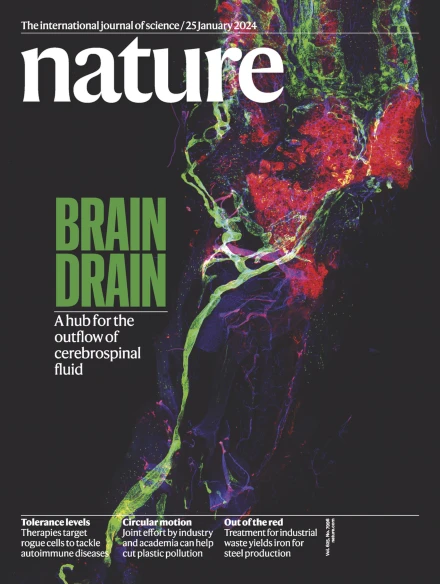Cell cycle duration determines oncogenic transformation capacity
IF 50.5
1区 综合性期刊
Q1 MULTIDISCIPLINARY SCIENCES
引用次数: 0
Abstract
Oncogenic mutations are widespread in normal human tissues1. Similarly, in murine chimeras, cells carrying an oncogenic lesion contribute normal cells to adult tissues without causing cancer2–4. How lineages that escape cancer via normal development differ from the minority that succumb is unclear. Tumours exhibit characteristic cancer hallmarks; we therefore searched for hallmarks that differentiate cancer-prone lineages from resistant lineages. Here we show that total cell cycle duration (Tc) predicts transformation susceptibility across multiple tumour types. Cancer-prone Rb- and p107-deficient retina (Rb is also known as Rb1 and p107 is also known as Rbl1) exhibited defects in apoptosis, senescence, immune surveillance, angiogenesis, DNA repair, polarity and proliferation. Perturbing the SKP2–p27–CDK2/CDK1 axis could block cancer without affecting these hallmarks. Thus, cancer requires more than the presence of its hallmarks. Notably, every tumour-suppressive mutation that we tested increased Tc, and the Tc of the cell of origin of retinoblastoma cells was half that of resistant lineages. Tc also differentiated the cell of origin in Rb−/− pituitary cancer. In lung, loss of Rb and p53 (also known as Trp53) transforms neuroendocrine cells, whereas KrasG12D or BrafV600E mutations transform alveolar type 2 cells5–7. The shortest Tc consistently identified the cell of origin, regardless of mutation timing. Thus, relative Tc is a hallmark of initiation that distinguishes cancer-prone from cancer-resistant lineages in several settings, explaining how mutated cells escape transformation without inducing apoptosis, senescence or immune surveillance. Total cell cycle duration is a key hallmark of cancer initiation, and determines whether defects in apoptosis, senescence, immune surveillance, angiogenesis, DNA repair, polarity and proliferation lead to cancer development.


细胞周期持续时间决定了致癌转化能力
致癌突变在正常人体组织中广泛存在。同样,在小鼠嵌合体中,携带致癌病变的细胞将正常细胞贡献给成年组织,而不会导致癌症2,3,4。通过正常发育逃离癌症的谱系与少数死亡谱系有何不同尚不清楚。肿瘤表现出特有的癌症特征;因此,我们寻找区分易患癌症谱系和耐药谱系的标志。在这里,我们展示了总细胞周期持续时间(Tc)预测多种肿瘤类型的转化易感性。易患癌的Rb和p107缺陷视网膜(Rb也被称为Rb1, p107也被称为Rbl1)在凋亡、衰老、免疫监视、血管生成、DNA修复、极性和增殖方面存在缺陷。干扰SKP2-p27-CDK2 /CDK1轴可以在不影响这些标志的情况下阻断癌症。因此,癌症需要的不仅仅是其特征的存在。值得注意的是,我们测试的每一个肿瘤抑制突变都增加了Tc,视网膜母细胞瘤细胞起源细胞的Tc是耐药谱系的一半。Tc也分化了Rb−/−垂体癌的起源细胞。在肺中,Rb和p53(也称为Trp53)的缺失会转化神经内分泌细胞,而KrasG12D或BrafV600E突变会转化肺泡2型细胞5,6,7。无论突变时间如何,最短的Tc一致地识别了起源细胞。因此,相对Tc是在几种情况下区分癌症易感性和癌症抗性谱系的起始标志,解释了突变细胞如何在不诱导细胞凋亡、衰老或免疫监视的情况下逃避转化。
本文章由计算机程序翻译,如有差异,请以英文原文为准。
求助全文
约1分钟内获得全文
求助全文
来源期刊

Nature
综合性期刊-综合性期刊
CiteScore
90.00
自引率
1.20%
发文量
3652
审稿时长
3 months
期刊介绍:
Nature is a prestigious international journal that publishes peer-reviewed research in various scientific and technological fields. The selection of articles is based on criteria such as originality, importance, interdisciplinary relevance, timeliness, accessibility, elegance, and surprising conclusions. In addition to showcasing significant scientific advances, Nature delivers rapid, authoritative, insightful news, and interpretation of current and upcoming trends impacting science, scientists, and the broader public. The journal serves a dual purpose: firstly, to promptly share noteworthy scientific advances and foster discussions among scientists, and secondly, to ensure the swift dissemination of scientific results globally, emphasizing their significance for knowledge, culture, and daily life.
 求助内容:
求助内容: 应助结果提醒方式:
应助结果提醒方式:


